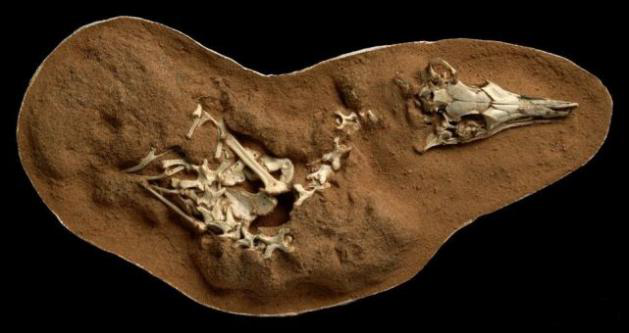
Small dinosaurs once lived in the desert in today's Mongolia and northern China. Their great night vision and strong hearing made them deadly predators during the nighttime. Scientists said they have found a circle of bones around the eye of a dinosaur called Shuvuuia Deserti. The bones were inside the skull, which holds the hearing organ. Scientists say the dinosaur had hearing and sight abilities much like an owl, meaning it could hunt in the dark.
Their study was published in the journal, Science. The research showed that most predatory dinosaurs had good hearing, but their sight worked best during the daytime. The Shuvuuia, however, loved nightlife.
The two-legged dinosaur was the size of a large bird and weighed about as much as a house cat. It had many small teeth, like pieces of rice. It was lightweight and lived during the Cretaceous Period, about 75 million to 81 million years ago. Roger Benson is a paleontologist (古生物学家) from the University of Oxford who helped write the study. "It's such a strange animal that paleontologists have long wondered what it was actually doing," he said.
Its mid-length neck, small head, and very long legs, made it look like an unusual chicken. But unlike birds, it had short, strong arms with a large claw on the end, which was useful for digging. Jonah Choiniere is a paleontologist at Wits University in South Africa and the study's lead author. "Shuvuuia might have run across the desert floor under cover of night, using its incredible hearing and night vision to track small prey such as nocturnal mammals, lizards and insects," he said.
The researchers also looked at a structure called the lagena. The lagena is a curved sack that sits in an area of bones around the brain. It is connected to the part of the ear that lets reptiles (爬行动物) and birds keep balance and move their heads while walking. The longer the lagena, the better hearing an animal has.
本时文内容由奇速英语国际教育研究院原创编写,未经书面授权,禁止复制和任何商业用途,版权所有,侵权必究!(作者投稿及时文阅读定制请联系微信:18980471698)
1.Why was the Shuvuuia Deserti a threat to other animals?
A Because it has good eyesight in the darkness.
B Because it has an ability of hunting at night.
C Because it can easily find prey through its hearing.
D Because it is better evolved than other dinosaurs.
解析:选B。B细节理解题。根据第一段Their great night vision and strong hearing made them deadly predators during the nighttime.及... meaning it could hunt in the dark.可知,鸟面龙(Shuvuuia Deserti)强大的夜视能力和听力使它们在夜间成为致命的捕食者。故选B。
2.According to Paragraph 3, the writer describes the Shuvuuia by ______. a. giving reasons b. listing numbers c. giving quotations d. making comparison
A a; b
B b; c
C c; d
D a; b; c; d
解析:选C。C细节理解题。根据第三段可知,这种两腿恐龙有大鸟那么大,体重和家猫差不多。它有许多小牙齿,像米粒。它很轻,生活在约7500万到8100万年前的白垩纪时期。作者还引用了罗杰·本森的观点。故选C。
3.Which of the following statements is TRUE according Paragraph 4?
A The Shuvuuia’s arms assist it to catch prey during nights.
B The Shuvuuia has some habits as chickens and birds.
C The Shuvuuia is accustomed to the desert environment.
D The Shuvuuia takes advantage of the night and abilities to hunt.
解析:选D。D推理判断题。根据第四段Shuvuuia might have run across the desert floor under cover of night, using its incredible hearing and night vision to track small prey可知,鸟面龙可能在夜色的掩护下穿越沙漠,用其惊人的听觉和夜视能力来追踪小猎物。故选D。
4.What’s the function of the lagena?
A It determines animals’ ability of hearing.
B It helps animals keep balance and move.
C It makes animals turn around more easily.
D It helps animals live in the darkness.
解析:选A。A推理判断题。根据最后一段可知,听壶(lagena)连接着耳朵的那个让爬行动物和鸟类在行走时保持平衡并移动头部的部分。听壶越长,动物的听力就越好。推断听壶决定着动物的听力。故选A。